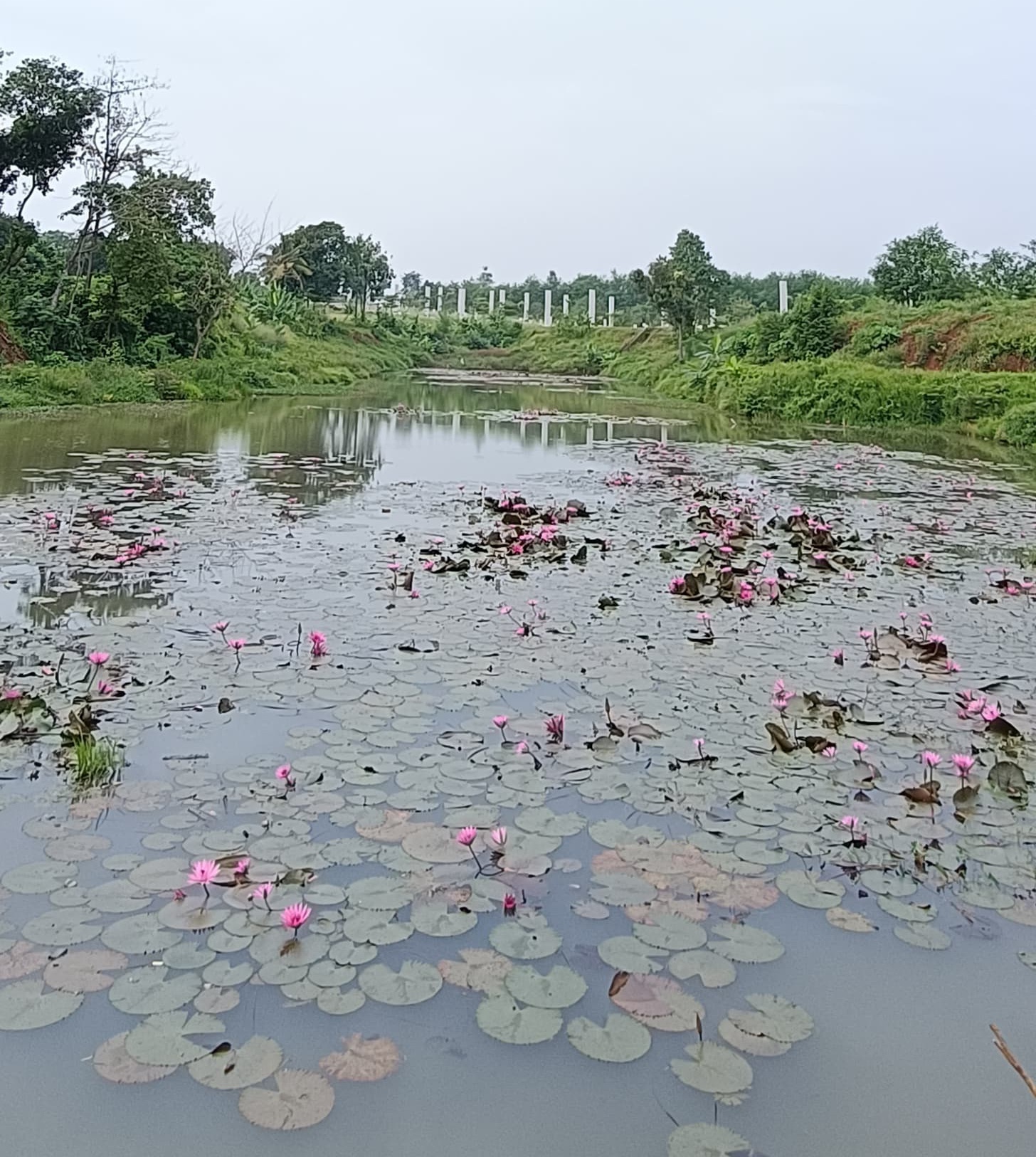More From News
A Lotus Blooming in Depok
November 24, 2025
November 24, 2025
By Dadi Darmadi

Depok, Indonesia — 20 November 2025 — As the first rays of sunlight spill across the dome of the Rahmatan Lil ‘Alamiin Mosque, a quiet scene unfolds on the water below. The lake at the heart of Universitas Islam Internasional Indonesia (UIII) stirs to life—not with sound, but with color. Dozens of red lotuses, their petals unfurling like silk fans, rise from the still surface, transforming the campus’s once-forgotten pond into a living canvas of serenity and symbolism.
This is no ordinary danau tucked into a garden; it is a story of renewal: of nature, of space, and of spirit.
From Neglect to Sanctuary
Just a few years ago, the lake was little more than a stagnant basin, overlooked by both campus residents and local visitors. Today, it has become a new icon, and perhaps the soul, of the university. The transformation is most vivid in the early morning, when mist clings to the water and the lotuses, known locally as bunga teratai merah, begin their daily bloom.
The lake lies cradled between two architectural anchors of the campus: the gleaming white mosque and the angular glass façade of the JK Library. Between them, the red blossoms rise on thick green stalks, their broad leaves floating like lily pads in a European painting. The scene is so striking that passersby often pause mid-commute, drawn into a moment of unexpected stillness.
“For me, stopping here for five minutes before work is a form of therapy,” says M. Nurhidayat, a campus caretaker who has watched the lake’s transformation with quiet pride. “Seeing those beautiful red flowers, so pure and perfect despite growing from the mud—it’s a silent reminder of my own journey.”
 A Flower With Many Roots
A Flower With Many Roots
The lotus is no ordinary bloom. Revered across cultures and faiths—from Qur’anic metaphors of purity to Buddhist and Hindu symbols of enlightenment—it is a botanical embodiment of transcendence. Its roots sink into murky depths, yet its petals emerge untouched, radiant.
“Just as the lotus rises clean and beautiful from the mud, we hope our academic community strives for knowledge and integrity, untainted by the distractions of the world,” says Prof. Dr. Jamhari Makruf, UIII’s rector. “To have them blooming before the mosque, a house of worship, and the library, a house of knowledge, is profoundly symbolic.”
The symbolism is not lost on the students. The lake’s perimeter, now encircled by a gently curving walking path, has become a favorite spot for morning walks, quiet study breaks, and impromptu conversations. Benches invite reflection. The water mirrors not just the sky, but the aspirations of a campus community in motion.
Designing Stillness
The revitalization of the lake was no afterthought; it was a deliberate act of landscape storytelling. “We wanted to create a heart for the campus,” says Dr. Chaider Bamualim, UIII’s University Secretary. “A place that isn’t just about passing through, but about being.” The revitalized lake and its lotus ecosystem are also part of UIII’s broader commitment to becoming a green campus; integrating sustainability, biodiversity, and mindful design into the university’s academic and physical landscape.
For Imansari Ujianty, Head of Administration and Protocol at the University Secretariat, the lotus is more than flora. “It is metaphor. It is memory. It is a daily reminder that growth often begins in obscurity, and that true, enduring beauty emerges from struggle,” she reflects.
Across Java, the lotus has long captivated the imagination—not only as a spiritual symbol, but as a botanical marvel. Nowhere is this more evident than in the historic grounds of Kebun Raya Bogor, Indonesia’s oldest botanical garden, where the Victoria amazonica, giant water lilies native to the Amazon River, float like emerald saucers in the ponds of Taman Astrid. With leaves spanning up to 1.5 meters in diameter, these colossal lilies can support the weight of a small child, their ribbed undersides engineered by nature to defy gravity and time. The sight of their pale pink blooms rising from the water’s surface draws visitors from around the world, eager to witness a species that seems to belong to another era.
Yet the garden’s collection doesn’t end with the giants of South America. Nearby, in a quieter corner facing the presidential palace, native Indonesian lotus varieties from Papua and West Java bloom in more modest scale but equal splendor. Their delicate forms and regional diversity offer a living contrast to their Amazonian cousins—reminding us that beauty, like resilience, comes in many forms. From the curated ponds of Bogor to the revitalized lake at UIII, the lotus continues to bridge continents, cultures, and centuries, blooming wherever water, patience, and reverence allow.
A Living Legacy
As the sun climbs higher and the campus hums with activity, the lake remains still. The lotuses, now fully open, seem to float in quiet defiance of the world’s noise. They do not demand attention. They invite it.
At a university founded to bridge faith and reason, tradition and modernity, the lake has quietly emerged as a third presence: nature. In its red blossoms, UIII has discovered a new kind of classroom—one where the lessons are wordless, yet deeply profound, and where sustainability takes root as part of the university’s commitment to becoming a green campus.
Here, in the heart of Depok, a lotus blooms. And with it, so does a vision of harmony—between people, place, and purpose.
Universitas Islam Internasional Indonesia